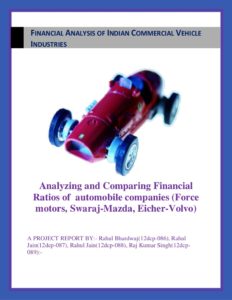
The company is also renowned of establishing a number of successful joint ventures and acquisitions throughout the world. In 2005 the company established a joint venture with Fiat Group Automobiles at Rajangaon (Maharashtra) to manufacture Tata and Fiat cars along with Fiat powertrains. The major acquisition of Tata Motors includes ‘Daewoo’ in 2004 which is South Korea’s second largest truck maker and ‘Jaguar Land Rover’ in 2008. In the year 2004 the company was listed in New York Stock Exchange. Tata Motors is also having business in number of other countries like Thailand, South Africa UK, South Korea and Indonesia through its subsidiaries and associate companies. The company is engaged in manufacturing both commercial and passenger vehicles which are being marketed in several countries like Africa, Middle East, South East Asia, Europe, South Asia, South America, Australia, Russia and it also has joint ventures in Ukraine, Bangladesh and Senegal. The cars and utility vehicles manufactures by Tata Motors in India includes Nano, Bolt, Vista, Indica, Zest, Manza, Indigo, Safari Storme, Safari Dicor, Sumo Gold, Movus, Venture, Xenon XT, Aria. Apart from cars and utility vehicles the company also manufactures small pickups like magic, ace and winger, trucks like Prima and Construck, buses and even defence vehicles for the Indian Army.
Current ratio or working capital ratio is calculated to judge the ability of firm to meet its short term liabilities or current liabilities on time. Current ratio is used to explain the relationship between current assets and current liabilities of an enterprise. Current assets are those assets which can be easily converted into cash within one year such as cash in hand, cash at bank, raw materials, debtors, bills receivables etc. On the other hand current liabilities are those liabilities which mature for payment within a year such as creditors, bills payable, interest payable, dividend payable etc.
Thus Current Ratio = Current Assets ÷ Current Liabilities. As per standard current ratio of 2:1 is considered to be satisfactory which means that current assets are twice the current liabilities. If current assets are twice or more than twice the current liabilities it reveals that a firm will not find any difficulty to meet its current liabilities on time. On the other hand if current assets are less than twice the current liabilities it means that a firm may face difficulty to pay off its current liabilities whenever they become due. If current ratio is less than 2:1 it reflects lack of working capital and shortage of liquidity in a firm.
Leave a Reply Cancel reply
Categories
- Animal27
- Apps3
- Art70
- Auto50
- Business175
- Career1
- Education114
- Faith62
- Family186
- Fashion35
- Food67
- Gadgets16
- Gaming13
- Health139
- Hobby134
- Holidays26
- Home96
- Legal11
- Marketing40
- Money96
- News130
- News30
- Other Stories4
- Pet1
- Photography14
- Poem23
- Science28
- SkyPip3
- Social Network75
- Society159
- Software23
- Technology125
- Travel69






Leave a Reply